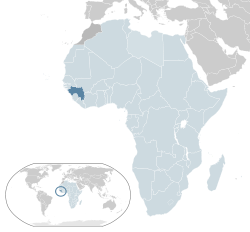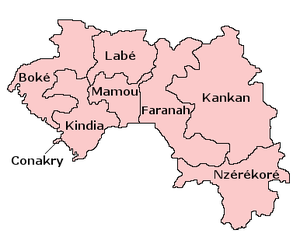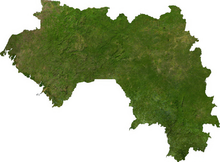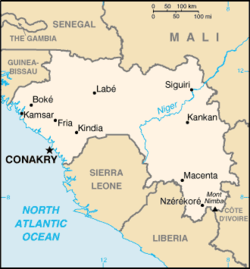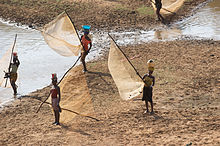
Guinea
About this schools Wikipedia selection
SOS Children, which runs nearly 200 sos schools in the developing world, organised this selection. All children available for child sponsorship from SOS Children are looked after in a family home by the charity. Read more...
| Republic of Guinea République de Guinée
|
||||||
|---|---|---|---|---|---|---|
|
||||||
| Motto: "Travail, Justice, Solidarité" (French) "Work, Justice, Solidarity" |
||||||
| Anthem: Liberté (French) Freedom |
||||||
|
Location of Guinea (dark blue)
– in Africa (light blue & dark grey) |
||||||
| Capital and largest city |
Conakry 9°31′N 13°42′W |
|||||
| Official languages | French | |||||
| Vernacular languages |
|
|||||
| Ethnic groups |
|
|||||
| Demonym | Guinean | |||||
| Government | Presidential republic | |||||
| - | President | Alpha Condé | ||||
| - | Prime Minister | Mohamed Said Fofana | ||||
| Legislature | National Assembly | |||||
| Independence | ||||||
| - | from France | 2 October 1958 | ||||
| Area | ||||||
| - | Total | 245,857 km2 ( 78th) 94,926 sq mi |
||||
| - | Water (%) | negligible | ||||
| Population | ||||||
| - | July 2009 estimate | 10,057,975 ( 81st) | ||||
| - | 1996 census | 7,156,407 | ||||
| - | Density | 40.9/km2 106.1/sq mi |
||||
| GDP ( PPP) | 2011 estimate | |||||
| - | Total | $11.464 billion | ||||
| - | Per capita | $1,082 | ||||
| GDP (nominal) | 2011 estimate | |||||
| - | Total | $5.212 billion | ||||
| - | Per capita | $492 | ||||
| Gini (1994) | 40.3 medium |
|||||
| HDI (2010) | low · 178th |
|||||
| Currency | Guinean franc ( GNF) |
|||||
| Time zone | ( UTC+0) | |||||
| Drives on the | right | |||||
| Calling code | +224 | |||||
| Internet TLD | .gn | |||||
Guinea / ˈ ɡ ɪ n i /, officially the Republic of Guinea (French: République de Guinée), is a country in West Africa. Formerly known as French Guinea (French: Guinée française), it is today sometimes called Guinea-Conakry to distinguish it from its neighbour Guinea-Bissau and the Republic of Equatorial Guinea. It has a population of 10,057,975 and an area of 246,000 square kilometres (94,981 sq mi). Forming a crescent as it curves from its western border on the Atlantic Ocean toward the east and the south, it shares its northern border with Guinea-Bissau, Senegal, and Mali, and its southern border with Sierra Leone, Liberia, and Côte d'Ivoire. The sources of the Niger River, Gambia River, and Senegal River are all found in the Guinea Highlands.
Conakry is Guinea's capital, largest city, and economic centre. Other major cities in the country include Kankan, Nzérékoré, Kindia, Labe, Guéckédou, Mamou and Boke. Guinea's 10 million people belong to twenty-four ethnic groups. The largest and most prominent groups are the Fula (40%), Mandingo (30%), and Susu (20%). It is a predominantly Islamic country, with Muslims representing about 85 percent of the population. Christians, mostly Roman Catholic, make up about 10 percent of the population, and are mainly found in the southern ( Guinée forestière) region. French is the official language of Guinea, and is the main language of communication in schools, government administration, the media, and the country's security forces. More than twenty four indigenous languages are also spoken, of which the most common are Fula, Susu and Maninka. Fula is widely used in the Fouta Djallon region in central Guinea, Maninka in Eastern Guinea, and Susu in the coastal region of northwestern Guinea.
Guinea's economy is largely dependent on agriculture and mineral production. It is the world's second largest producer of bauxite, and has rich deposits of diamonds and gold.
The issue of human rights in the country remains controversial. In its 2012 Freedom in the World report, Freedom House named the country "partly free" for the second year in a row, an improvement over its former status as one of the least free countries in Africa. The United States Bureau of Democracy, Human Rights and Labor, which produces annual human rights reports on the country, claims the most pressing human rights issues are the use of torture by security forces, and abuse of women and children through such acts as female genital mutilation.
History
The land that is now Guinea belonged to a series of African empires until France colonized it in the 1890s, and made it part of French West Africa. Guinea declared its independence from France on 2 October 1958. From independence until the presidential election of 2010, Guinea was governed by a number of autocratic rulers, which has contributed to making Guinea one of the poorest countries in the world.
Ahmed Sékou Touré rule
Ahmed Sékou Touré became President upon Guinea's independence in 1958, establishing one-party dictatorship, with a closed, socialized economy and no tolerance for human rights, free expression, or political opposition, which was ruthlessly suppressed. The country was named the People's Revolutionary Republic of Guinea.
Economic costs were extensive. The state took over farms and other production. Imposition of price controls started an era of pervasive black markets and smuggling even though it was punishable by death. Touré relied on his own Malinke ethnic group to fill positions in the party and government. Touré's party officials took monopoly of social and economic life. A police and intelligence apparatus spied on everyone. More than a million people fled the repression into neighboring countries. It has been estimated that almost 5,000 people were executed or died from torture or starvation at the Camp Boiro, a Soviet-style concentration camp.
After almost three decades in power, Touré died unexpectedly on 26 March 1984.
Recent history
In a coup d'état several hours following Touré's death, Lansana Conté became the President. The constitution and parliament were suspended and a committee for national recovery was established. Conté remained in power until his death on 23 December 2008.
In several hours following his death, Moussa Dadis Camara seized control of Guinea as the head of a junta. On 28 September 2009, the junta ordered its soldiers to attack people who had gathered to protest any attempt by Camara to become President. The soldiers went on a rampage of rape, mutilation, and murder.
On 3 December 2009, an aide shot Camara during a dispute about the rampage of September 2009. Camara went to Morocco for medical care. Vice-President (and defense minister) Sékouba Konaté flew back from Lebanon to run the country in Camara's absence.
On 12 January 2010 Camara was flown from Morocco to Burkina Faso. After meeting in Ouagadougou on 13 and 14 January, Camara, Konaté and Blaise Compaoré, President of Burkina Faso, produced a formal statement of twelve principles promising a return of Guinea to civilian rule within six months. It was agreed that the military would not contest the forthcoming elections, and Camara would continue his convalescence outside Guinea. On 21 January 2010 the military junta appointed Jean-Marie Doré as Prime Minister of a six-month transition government, leading up to elections.
The presidential election was set to take place on 27 June and 18 July 2010, it was held as being the first free and fair election since independence in 1958. The first round took place normally on 27 June 2010 with ex Prime Minister Cellou Dalein Diallo and his rival Alpha Condé emerging as the two runners-up for the second round. However, due to allegations of electoral fraud, the second round of the election was postponed until 19 September 2010. A delay until 10 October was announced by the electoral commission (CENI), subject to approval by Sékouba Konaté. Yet another delay until 24 October was announced in early October. Elections were finally held on 7 November. Voter turnout was high, and the elections went relatively smoothly.
16 November 2010, Alpha Condé, the leader of the opposition party Rally of the Guinean People (RGP), was officially declared the winner of a 7 November run-off in Guinea's presidential election. He has promised to reform the security sector and review mining contracts if elected.
On the night of 18 July 2011, President Condé's residence was attacked in an attempted coup. The attack included a fierce firefight and rocket propelled grenades. The president was unharmed. Sixteen people have been charged with the attempted assassination. Most of those indicted are close associates of Konaté.
The National Assembly of Guinea, the country's legislative body, has not met since 2008 when it was dissolved after the military coup in December. Elections have been postponed many times since 2007 and, most recently, were scheduled for 8 July 2012. In April 2012, President Condé postponed the elections indefinitely, citing the need to ensure that they were "transparent and democratic".
In February 2013, a plane carrying the head of the Guinean armed forces, General Kelefa Diallo, and nine other military officials, crashed on its way to the Liberian capital, Monrovia.
2013 Protests
In late February 2013, political violence erupted in Guinea after protesters took to the streets to voice their concerns over the transparency of the upcoming May 2013 elections. The demonstrations were fueled by the opposition coalition’s decision to step down from the electoral process in protest at the lack of transparency in the preparations for elections. Nine people were killed during the protests, while around 220 were injured, and many of the deaths and injuries were caused by security forces using live fire on protesters. The political violence also led to inter-ethnic clashes between the Peul and Malinke people, the latter forming the base of support for President Condé, with the former consisting mainly of the opposition. On March 26, 2013 the opposition party backed out of the negotiation with the government over the upcoming May 12 election. The opposition claimed that the government has not respected them, and have not kept any promises they agreed to. This is expected to lead to more protests and fighting in the streets of Guinea.
Regions and prefectures
The Republic of Guinea covers 245,857 square kilometres (94,926 sq mi) of West Africa about 10 degrees north of the equator. Guinea is divided into four natural regions with distinct human, geographic, and climatic characteristics:
- Maritime Guinea (La Guinée Maritime) covers 18% of the country
- Mid-Guinea (La Moyenne-Guinée) covers 20% of the country
- Upper-Guinea (La Haute-Guinée) covers 38% of the country
- Forested Guinea ( Guinée forestière) covers 23% of the country, and is both forested and mountainous
Guinea is divided into seven administrative regions and subdivided into thirty-three prefectures.
| Region | Capital | Population(2010) |
|---|---|---|
| Conakry Region | Conakry | 2,325,190 |
| Nzérékoré Region | Nzérékoré | 1,528,908 |
| Kankan Region | Kankan | 1,427,568 |
| Kindia Region | Kindia | 1,326,727 |
| Boké Region | Boké | 965,767 |
| Labé Region | Labé | 903,386 |
| Faranah Region | Faranah | 839,083 |
| Mamou Region | Mamou | 719,011 |
- The capital Conakry with a population of 1,548,470 ranks as a special zone.
Geography
At 245,857 km2 (94,926 sq mi), Guinea is roughly the size of the United Kingdom and slightly smaller than the US state of Oregon. There are 320 km (200 mi) of coastline and a total land border of 3,400 km (2,100 mi). Its neighbours are Côte d'Ivoire (Ivory Coast), Guinea-Bissau, Liberia, Mali, Senegal and Sierra Leone. It lies mostly between latitudes 7° and 13°N, and longitudes 7° and 15°W (a small area is west of 15°).
The country is divided into four main regions: the Basse-Coté lowlands, populated mainly by the Susu ethnic group; the cooler, mountainous Fouta Djallon that run roughly north-south through the middle of the country, populated by Fulas, the Sahelian Haute-Guinea to the northeast, populated by Malinké, and the forested jungle regions in the southeast, with several ethnic groups. Guinea's mountains are the source for the Niger, the Gambia, and Senegal Rivers, as well as the numerous rivers flowing to the sea on the west side of the range in Sierra Leone and Côte d'Ivoire.
The highest point in Guinea is Mount Nimba at 1,752 m (5,748 ft). Although the Guinean and Ivorian sides of the Nimba Massif are a UNESCO Strict Nature Reserve, the portion of the so-called Guinean Backbone continues into Liberia, where it has been mined for decades; the damage is quite evident in the Nzérékoré Region at 7°32′17″N 8°29′50″W.
Economy
Guinea has abundant natural resources including 25 percent or more of the world's known bauxite reserves. Guinea also has diamonds, gold, and other metals. The country has great potential for hydroelectric power. Bauxite and alumina are currently the only major exports. Other industries include processing plants for beer, juices, soft drinks and tobacco. Agriculture employs 80 percent of the nation's labor force. Under French rule, and at the beginning of independence, Guinea was a major exporter of bananas, pineapples, coffee, peanuts, and palm oil.
Mining
Guinea possesses over 25 billion tonnes (metric tons) of bauxite – and perhaps up to one-half of the world's reserves. In addition, Guinea's mineral wealth includes more than 4-billion tonnes of high-grade iron ore, significant diamond and gold deposits, and undetermined quantities of uranium. Guinea has considerable potential for growth in agricultural and fishing sectors. Soil, water, and climatic conditions provide opportunities for large-scale irrigated farming and agro industry. Possibilities for investment and commercial activities exist in all these areas, but Guinea's poorly developed infrastructure and rampant corruption continue to present obstacles to large-scale investment projects.
Joint venture bauxite mining and alumina operations in northwest Guinea historically provide about 80% of Guinea's foreign exchange. Bauxite is refined into alumina, which is later smelted into aluminium. The Compagnie des Bauxites de Guinea (CBG), which exports about 14 million tonnes of high-grade bauxite annually, is the main player in the bauxite industry. CBG is a joint venture, 49% owned by the Guinean Government and 51% by an international consortium known as Halco Mining Inc., a joint venture of Dadco Mining and Rio Tinto Alcan. The Compagnie des Bauxites de Kindia (CBK), a joint venture between the Government of Guinea and RUSAL, produces some 2.5 million tonnes annually, nearly all of which is exported to Russia and Eastern Europe. Dian Dian, a Guinean/Ukrainian joint bauxite venture, has a projected production rate of 1,000,000 t (1,102,311 short tons; 984,207 long tons) per year, but is not expected to begin operations for several years. The Alumina Compagnie de Guinée (ACG), which took over the former Friguia Consortium, produced about 2.4 million tonnes in 2004 as raw material for its alumina refinery. The refinery exports about 750,000 tonnes of alumina. Both Global Alumina and Alcoa-Alcan have signed conventions with the Government of Guinea to build large alumina refineries with a combined capacity of about 4 million tonnes per year.
Diamonds and gold also are mined and exported on a large scale. AREDOR, a joint diamond-mining venture between the Guinean Government (50%) and an Australian, British, and Swiss consortium, began production in 1984 and mined diamonds that are 90% gem quality. Production stopped from 1993 until 1996, when First City Mining, of Canada, purchased the international portion of the consortium. The bulk of diamonds are mined artisanally. The largest gold mining operation in Guinea is a joint venture between the government and Ashanti Goldfields of Ghana. Société Minière de Dinguiraye (SMD) also has a large gold mining facility in Lero, near the Malian border.
Guinea has large reserves of the steel-making raw material, iron ore. Rio Tinto is the majority owner of the $6 billion Simandou iron ore project, which the firm says is the world's best unexploited resource. Rio Tinto has signed a binding agreement with Aluminium Corp. of China Ltd. to establish the joint venture for the Simandou iron ore project. This project is said to be of the same magnitude as the Pilbara in Western Australia. In the 1960s, Thomas Price, then vice president of US-based steel company Kaiser Steel, said, "I think this [the Pilbara] is one of the most massive ore bodies in the world."
Mining Code
In September 2011, Guinea adopted a new mining code. The law set up a commission to review deals struck during the chaotic days between the end of dictatorship in 2008 and Condé coming to power.
Controversy
In June 2012 The Sunday Times revealed that in April 2011, five months before the Mining Code became law, Mohamed Lamine Fofana, the mining minister, agreed a USD25 million loan with Palladino Capital, an investment vehicle registered in the British Virgin Islands by South African business man Walter Hennig. The deal was also signed by the finance minister, Kerfalla Yansane and Samuel Mebiane, who was listed as a “proxy holder” for Palladino. This loan of US$25 million has never been publicly revealed to Guineans, or ticked off in the national budget, although President Alpha Condé has said that "contracts that commit Guinea will be published on the Internet." The terms of the loan include a provision that if the Guinean government defaults, Palladino can convert the debt into an equivalent value in shares in the operations of one of the subsidiaries of the national mining company to a maximum of 30% stake.
According to independently confirmed sources and an investigation conducted by Business Day of Johannesberg, Tokyo Sexwale, Mark Willcox (CEO of Sexwale’s Mvelaphanda Holdings) and several other businessmen of "South African, Polish, and British extraction" are behind Hennig and the $25 million loan. This type of agreement is in violation with the Mining Code, which stipulates in Article 150 that "The State reserves the right to sell all or part of its participation in cash, without pre-emption rights of other shareholders of the holder of the mining company, through a bidding process that is open and transparent."
Labour MP Eric Joyce is one of many who believe the loan could allow Palladino Capital, and by extension Walter Hennig, to gain a large stake in Guinea’s mining industry at a bargain price. George Soros has called on the Guinean government to fully investigate the loan.
The loan was allegedly intended as a start-up for a state mining company though any potential investigation into the matter now will have to determine whether this was the genuine motive or whether the loan was intended to benefit political or individual interests in return for mining concessions.
As a result of the loan to Guinea, the firm was to be granted as much as 49% of the equity stake and voting rights in the state mining company, as well as the option to choose to negotiate minority or majority stakes in any state-linked mining asset without reference to an open-bid licence process. Additionally, Guinea would not be permitted to sell any state interest in a mining asset without first offering the option to Palladino and should the firm wish to acquire a stake in a mining asset, it would be granted the privilege of a six-month negotiating period. If a deal could not then be struck, Guinea would only be allowed to negotiate with a third party without first right of refusal from Palladino.
Problems and reforms
The Guinean Government adopted policies in the 1990s to return commercial activity to the private sector, promote investment, reduce the role of the state in the economy, and improve the administrative and judicial framework. Guinea has the potential to develop, if the government carries out its announced policy reforms, and if the private sector responds appropriately. So far, corruption and favouritism, lack of long-term political stability, and the lack of a transparent budgeting process continue to dampen foreign investor interest in major projects in Guinea.
Reforms since 1985 include eliminating restrictions on agriculture and foreign trade, liquidation of some government-owned corporations, the creation of a realistic exchange rate, increased spending on education, and cutting the government bureaucracy. In July 1996, President Lansana Conté appointed a new government, which promised major economic reforms, including financial and judicial reform, rationalization of public expenditures, and improved government revenue collection. Under 1996 and 1998 International Monetary Fund (IMF)/ World Bank agreements, Guinea continued fiscal reforms and privatization, and shifted governmental expenditures and internal reforms to the education, health, infrastructure, banking, and justice sectors.
The government revised the private investment code in 1998 to stimulate economic activity in the spirit of free enterprise. The code does not discriminate between foreigners and nationals and allows for repatriation of profits. While the code restricts development of Guinea's hydraulic resources to projects in which Guineans have majority shareholdings and management control, it does contain a clause permitting negotiations of more favourable conditions for investors in specific agreements. Foreign investments outside Conakry are entitled to more favourable terms. A national investment commission has been formed to review all investment proposals. Guinea and the United States have an investment guarantee agreement that offers political risk insurance to American investors through the Overseas Private Investment Corporation (OPIC). In addition, Guinea has inaugurated an arbitration court system, which allows for the quick resolution of commercial disputes.
Cabinet changes in 1999, which increased corruption, economic mismanagement, and excessive government spending, combined to slow the momentum for economic reform. The informal sector continues to be a major contributor to the economy.
Until June 2001, private operators managed the production, distribution, and fee-collection operations of water and electricity under performance-based contracts with the Government of Guinea. However, the two utilities are plagued by inefficiency and corruption. Foreign private investors in these operations departed the country in frustration.
In 2002, the IMF suspended Guinea's Poverty Reduction and Growth Facility (PRGF) because the government failed to meet key performance criteria. In reviews of the PRGF, the World Bank noted that Guinea had met its spending goals in targeted social priority sectors. However, spending in other areas, primarily defense, contributed to a significant fiscal deficit. The loss of IMF funds forced the government to finance its debts through Central Bank advances. The pursuit of unsound economic policies has resulted in imbalances that are proving hard to correct.
Under then-Prime Minister Diallo, the government began a rigorous reform agenda in December 2004 designed to return Guinea to a PRGF with the IMF. Exchange rates have been allowed to float, price controls on gasoline have been loosened, and government spending has been reduced while tax collection has been improved. These reforms have not reduced inflation, which hit 27% in 2004 and 30% in 2005. Currency depreciation is also a concern. The Guinea franc was trading at 2550 to the dollar in January 2005. It hit 5554 to the dollar by October 2006.
Despite the opening in 2005 of a new road connecting Guinea and Mali, most major roadways remain in poor repair, slowing the delivery of goods to local markets. Electricity and water shortages are frequent and sustained, and many businesses are forced to use expensive power generators and fuel to stay open.
Even though there are many problems plaguing Guinea's economy, not all foreign investors are reluctant to come to Guinea. Global Alumina's proposed alumina refinery has a price tag above $2 billion. Alcoa and Alcan are proposing a slightly smaller refinery worth about $1.5 billion. Taken together, they represent the largest private investment in sub-Saharan Africa since the Chad-Cameroon oil pipeline. Also, Hyperdynamics Corporation, an American oil company, signed an agreement in 2006 to develop Guinea's offshore Senegal Basin oil deposits in a concession of 31,000 square miles (80,000 km2); it is pursuing seismic exploration.
On 13 October 2009, Guinean Mines Minister Mahmoud Thiam announced that the China International Fund would invest more than $7bn (£4.5bn) in infrastructure. In return, he said the firm would be a "strategic partner" in all mining projects in the mineral-rich nation. He said the firm would help build ports, railway lines, power plants, low-cost housing and even a new administrative centre in the capital, Conakry. In September 2011, Mohamed Lamine Fofana, the Mines Minister following the 2010 election, said that the government had overturned the agreement by the ex-military junta.
Youth unemployment, however, remains a large problem. Guinea needs an adequate policy to address the concerns of the urban youth. The problem is the disparity between their life and what they see on television. As the youth cannot find jobs, seeing the economic power and consumerism of richer countries only serves to frustrate them further.
Oil
Guinea signed a Production sharing agreement with Hyperdynamics Corporation of Houston in 2006 to explore a large offshore tract, recently in partnership with Dana Petroleum PLC (Aberdeen, United Kingdom). The initial well, the Sabu-1, is scheduled to begin drilling in October 2011 at a site in approximately 700 meters of water. The Sabu-1 will target a four-way anticline prospect with upper Cretaceous sands and is anticipated to be drilled to a total depth of 3,600 meters.
Transportation
The railway from Conakry to Kankan ceased operating in the mid-1980s. Domestic air services are intermittent. Most vehicles in Guinea are 20+ years old, and cabs are any four-door vehicle which the owner has designated as being for hire. Locals, nearly entirely without vehicles of their own, rely upon these taxis (which charge per seat) and small buses to take them around town and across the country. There is some river traffic on the Niger and Milo rivers. Horses and donkeys pull carts, primarily to transport construction materials.
Iron mining at Simandou (South) in the southeast beginning in 2007 and at Kalia in the east is likely to result in the construction of a new heavy-duty standard gauge railway and deepwater port. Iron mining at Simandou (North) will load to a new port near Buchanan, Liberia, in exchange for which rehabilitation of the Conakry to Kankan line will occur.
Conakry International Airport is the largest airport in the country, with flights to other cities in Africa as well as to Europe.
Demography
The population of Guinea is estimated at 10.2 million. Conakry, the capital and largest city, is the hub of Guinea's economy, commerce, education, and culture.
Languages
The official language of Guinea is French. Other significant languages spoken are Pular (Fulfulde or Fulani) Maninka (Malinke), Susu, Kissi, Kpelle, and Loma.
Ethnicity
The population of Guinea comprises about 24 ethnic groups. The Fulas or Fulani (French: Peuls; Fula: Fulɓe), comprise 40% of the population and are mostly found in the Futa Djallon region. The Mandinka, also known as Mandingo or Malinké, comprise 30% of the population and are mostly found in eastern Guinea concentrated around the Kankan and Kissidougou prefectures. The Soussou, comprising 20%, are predominantly in western areas around the capital Conakry, Forécariah, and Kindia. Smaller ethnic groups make up the remaining 10% of the population, including Kpelle, Kissi, Zialo, Toma and others. Approximately 10,000 non-Africans live in Guinea, predominantly Lebanese, French, and other Europeans.
Religion
Islam is the majority religion. Approximately 85% of the population is Muslim, while 8% is Christian, and 7% holds traditional animist beliefs. Guinean Muslims are generally Sunni and Sufi; there are relatively few Shi'a in Guinea. Christian groups include Roman Catholics, Anglicans, Baptists, Seventh-day Adventists, and other Evangelical groups. Jehovah's Witnesses are active in the country and recognized by the Government. There is a small Baha'i community. There are small numbers of Hindus, Buddhists, and traditional Chinese religious groups among the expatriate community.
Military
Guinea's armed forces are divided into five branches – army, navy, air force, the paramilitary National Gendarmerie and the Republican Guard – whose chiefs report to the Chairman of the Joint Chiefs of Staff, who is subordinate to the Minister of Defense. In addition, regime security forces include the National Police Force (Sûreté National). The Gendarmerie, responsible for internal security, has a strength of several thousand.
The army, with about 15,000 personnel, is by far the largest branch of the armed forces. It is mainly responsible for protecting the state borders, the security of administered territories, and defending Guinea's national interests. Air force personnel total about 700. The force's equipment includes several Russian-supplied fighter planes and transports. The navy has about 900 personnel and operates several small patrol craft and barges.
Education and health
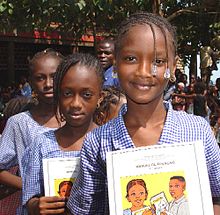
The literacy rate of Guinea is one of the lowest in the world: in 2003 it was estimated that only 29.5% of adults were literate (42.6% of males and 18.1% of females). Primary education is compulsory for 8 years, but most children do not attend for so long, and many do not go to school at all. In 1999, primary school attendance was 40 percent.Children, particularly girls, are kept out of school in order to assist their parents with domestic work or agriculture. Guinea has been reorganizing its health system since the Bamako Initiative of 1987 formally promoted community-based methods of increasing accessibility of drugs and health care services to the population, in part by implementing user fees. The new strategy dramatically increased accessibility through community-based healthcare (including community ownership and local budgeting), resulting in more efficient and equitable provision of services. A comprehensive strategy was extended to all areas of health care, with subsequent improvement in health indicators and improvement in health care efficiency and cost. Ethnographic research conducted in rural and urban areas of the Republic of Guinea explored perceived distinctions between biomedical and traditional health practices and found that these distinctions shape parental decisions in seeking infant health care, with 93% of all health expenditure taking place outside the state sector.
Guinea's public health code is defined by Law No. L/97/021/AN of 19 June 1997 promulgating the Public Health Code. The law provides for the protection and promotion of health and for the rights and duties of the individual, the family, and community throughout the territory of the Republic of Guinea.
In June 2011, the Guinean government announced the establishment of an air solidarity levy on all flights taking off from national soil, with funds going to UNITAID to support expanded access to treatment for HIV/AIDS, TB and malaria. Guinea is among the growing number of countries and development partners using market-based transactions taxes and other innovative financing mechanisms to expand financing options for health care in resource-limited settings.
Maternal and child health care
In June 2011, the United Nations Population Fund released a report on The State of the World's Midwifery. It contained new data on the midwifery workforce and policies relating to newborn and maternal mortality for 58 countries. The 2010 maternal mortality rate per 100,000 births for Guinea is 680. This is compared with 859.9 in 2008 and 964.7 in 1990. The under 5 mortality rate, per 1,000 births is 146 and the neonatal mortality as a percentage of under 5's mortality is 29. The aim of this report is to highlight ways in which the Millennium Development Goals can be achieved, particularly Goal 4 – Reduce child mortality and Goal 5 – improve maternal death. In Guinea the number of midwives per 1,000 live births is 1 and the lifetime risk of death for pregnant women is 1 in 26.
HIV/AIDS
The first cases of HIV/AIDS were reported in 1986. Though levels of AIDS are significantly lower than in a number of other African countries, as of 2005, Guinea was considered by the World Health Organization to face a generalized epidemic.
An estimated 170,000 adults and children were infected at the end of 2004. The spread of the epidemic was attributed to factors such as proximity to high-prevalence countries, a large refugee population, internal displacement and subregional instability.
Culture
Like other West African countries, Guinea has a rich musical tradition. The group Bembeya Jazz became popular in the 1960s after Guinean independence.


